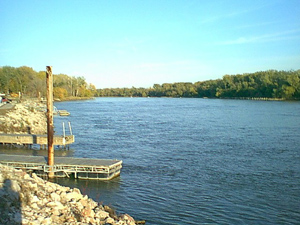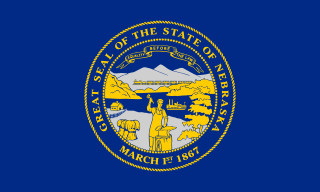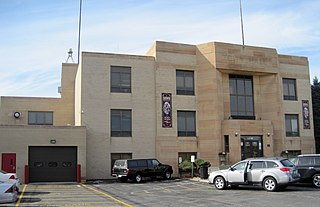
Johnny Rosenblatt Stadium was a baseball stadium in Omaha, Nebraska, the former home to the annual NCAA Division I College World Series and the minor league Omaha Royals, now known as the Omaha Storm Chasers. Rosenblatt Stadium was the largest minor league baseball stadium in the United States.

The Creighton Bluejays, or Jays, are the athletic teams that represent Creighton University, a Jesuit/Catholic University in Omaha, Nebraska, United States. They compete in NCAA Division I in the Big East Conference.

North Omaha is a community area in Omaha, Nebraska, in the United States. It is bordered by Cuming and Dodge Streets on the south, Interstate 680 on the north, North 72nd Street on the west and the Missouri River and Carter Lake, Iowa on the east, as defined by the University of Nebraska at Omaha and the Omaha Chamber of Commerce.
Kountze Park is an urban public park located at 1920 Pinkney Street in the Kountze Place neighborhood of North Omaha, Nebraska, in the United States. The Park is historically significant as the site of the Trans-Mississippi Exposition of 1898.

This is a list of parks in Omaha, Nebraska. It includes cemeteries and golf courses. Most parks in Omaha are governed by the City of Omaha Parks and Recreation Department.

Sports in Omaha, Nebraska are supported by a high attendance at events and tax support from the City of Omaha. Omaha, Nebraska is home to several professional sports teams and modern sports venues.
The Logan Fontenelle Housing Project was a historic public housing site located from 20th to 24th Streets, and from Paul to Seward Streets in the historic Near North Side neighborhood of Omaha, Nebraska, United States. It was built in 1938 by the Public Works Administration for housing working-class families. With the loss of thousands of industrial jobs in the 1950s and 1960s, the project became filled with families on welfare. As problems increased in the 1970s and 1980s, Logan Fontenelle was referred to as "Little Vietnam" because of drug dealing and gang violence. After Logan Fontenelle residents won a 1991 civil rights lawsuit brought against the Omaha Housing Authority and the U.S. Department of Housing and Urban Development, HUD tore down the projects in 1995 to replace them with new, lower density housing.

Pearl Memorial United Methodist Church was a member of the Nebraska Conference of the United Methodist Church that was operated from the 1890s into the 2000s. The former congregation's church is located at 2319 Ogden Street in the Miller Park neighborhood of north Omaha, Nebraska. The church primarily served the Miller Park community.

Boulevards in Omaha are part of a park and boulevard system originally designed in 1889 by Horace Cleveland. There are more than one hundred miles (160 km) of boulevards throughout the city of Omaha, Nebraska today.
Adams Park is located at 3121 Bedford Avenue in North Omaha, Nebraska. The community surrounding the park recently became the focus of urban planning by the Omaha Chamber of Commerce to promote redevelopment in the area.
Miller Park is located at 2707 Redick Avenue in North Omaha, Nebraska. Bounded by Redick and Kansas Avenues on the north and south and 24th and 30th Streets on the east and west, respectively, the park was added to the city of Omaha in 1891.
John A. Creighton Boulevard, is a boulevard-type north–south roadway in north Omaha, Nebraska. Running through the Adams Park neighborhood, the boulevard runs from Hamilton Avenue to Bedford Street. It originally ran from Lincoln Boulevard to Paxton Boulevard, ending in the Orchard Hill neighborhood.

Tourism in Omaha, Nebraska, United States offers visitors history, sports, nature and cultural experiences. Its principal tourist attractions are the Henry Doorly Zoo and the College World Series (CWS). A 2003 study by a Creighton University economist estimated that the CWS added $33.8 million to the city's economy that year. With 1.1 million visitors annually, the Henry Doorly Zoo is Nebraska's most popular tourist attraction. In 2007 Omaha hosted the USA Roller Sports National Championships, along with 10,000 people who auditioned for the American Idol television show at Qwest Center Omaha.

TD Ameritrade Park Omaha is a baseball park in Omaha, Nebraska. Opened in 2011, the stadium serves as a replacement for historic Johnny Rosenblatt Stadium.

The Elmwood Park neighborhood in Omaha, Nebraska is a historically significant area that was developed in the late 19th and early 20th century. It extends from Leavenworth Street on the north to Center Street on the south; from South 50th Street on the east to South 72nd Street on the west. Home to ethnic Swede celebrations through the 1950s, today the neighborhood's park hosts the city's "Shakespeare on the Green" festival.
Hitchcock Park is a public park located at 4220 "Q" Street in South Omaha, Nebraska. The park is regarded as a "popular South Omaha spot," along with the Henry Doorly Zoo and Rosenblatt Stadium. Due to a settlement between the U.S. Government and the City of Omaha, the park is subject to all enforcements of the Americans with Disabilities Act. The park is the location of one of three 50-meter pools in Omaha. It has also been identified as one of the many parks in Omaha poisoned with lead by the former ASARCO smelter in Downtown Omaha.

Rambleridge Park was developed in the late 1970s at 11424 Fort Street in Omaha, Nebraska. The park includes a lagoon, walking trails, soccer fields and a large green space for miscellaneous activities. A small playground is located farther in the neighborhood and can be reached after a short walk. The park and green spaces throughout the neighborhood are maintained by the City of Omaha and the residents of the neighborhood.
John Lajba, is an American sculptor who lives in Omaha, Nebraska. He is known for his work in creating sculptures of historical and sports figures, and creates the annual Harley J. Earl Trophies presented to the winner of the Daytona 500.
Brown Park is located at 5708 South 15th Street in the Brown Park neighborhood of South Omaha, Nebraska. The baseball field at the park is more than 100 years old, and hosted games played by Ty Cobb, Babe Ruth, Lou Gehrig, and others.


















